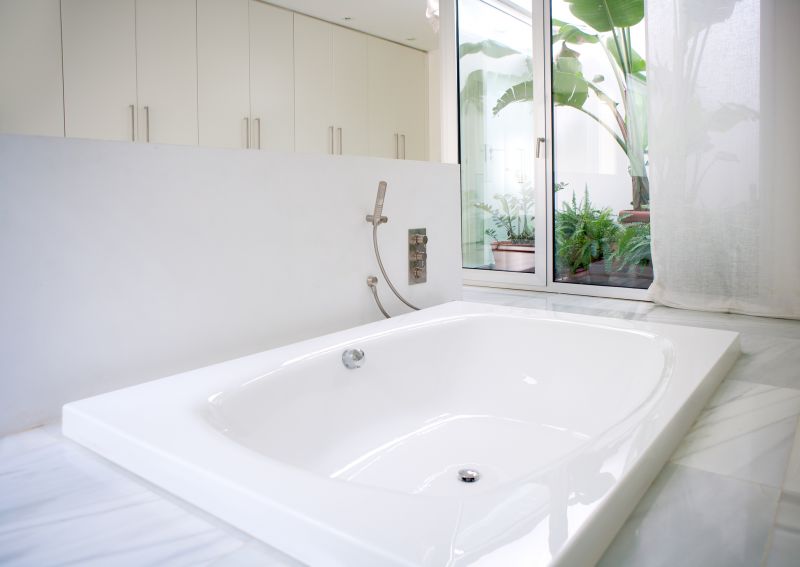Favorite Products For Bathtub Refinishings To Simplify Your Renovation
Explore user-approved products that make refinishing your bathtub straightforward and professional-looking.
 Bathtub refinishing is a popular solution for restoring the appearance and functionality of worn or outdated tubs without the need for full replacement. This process involves applying specialized coatings or paints designed to adhere to the surface of the bathtub, providing a fresh, smooth finish. It is often chosen for its cost-effectiveness and minimal disruption compared to traditional remodeling. When considering products for bathtub refinishing, it is essential to select high-quality materials that offer durability and a professional-looking finish.
Bathtub refinishing is a popular solution for restoring the appearance and functionality of worn or outdated tubs without the need for full replacement. This process involves applying specialized coatings or paints designed to adhere to the surface of the bathtub, providing a fresh, smooth finish. It is often chosen for its cost-effectiveness and minimal disruption compared to traditional remodeling. When considering products for bathtub refinishing, it is essential to select high-quality materials that offer durability and a professional-looking finish.
Top Overall Option
High-Performance Refinishing Coating
A high-performance refinishing coating designed for durability and smooth application, suitable for various bathtub surfaces. It offers resistance to stains, scratches, and water damage, providing a professional finish with proper application. Ideal for both DIY projects and professional use, this coating helps restore the appearance of bathtubs efficiently.
Types of Products For Bathtub Refinishings
Epoxy Paints
Durable and resistant to water and stains, epoxy paints are commonly used for refinishing bathtubs, offering a hard, glossy finish.
Acrylic Coatings
Flexible and easy to apply, acrylic coatings provide a smooth surface with good adhesion and color retention.
Urethane-Based Finishes
Known for their toughness and chemical resistance, urethane finishes are suitable for high-traffic bathtubs.
Refinishing Kits
Complete kits that include primers, fillers, and topcoats, designed for DIY refinishing projects.
Repair Fillers
Used to address chips, cracks, or surface imperfections before applying a topcoat.
Bonding Agents
Enhance adhesion of refinishing coatings to existing surfaces, ensuring longer-lasting results.
Etching Solutions
Prepare glazed or smooth surfaces for better adhesion of refinishing products.
Degreasers and Cleaners
Essential for thoroughly cleaning the surface prior to refinishing to ensure proper adhesion.
Protective Sealers
Applied after refinishing to add an extra layer of protection against water and stains.
Spray-On Coatings
Provide an even application for large or complex bathtub surfaces, often used in professional settings.
Brush-On Finishes
Suitable for detailed or smaller areas, offering control during application.
Roller Coatings
Ideal for larger, flat surfaces, providing quick and even coverage.
Popular Choices
Widely used for their ease of application and good adhesion, providing a smooth finish.
Known for their durability and resistance to moisture, often chosen for long-lasting results.
Popular for their chemical resistance and glossy appearance, suitable for high-use bathrooms.
Preferred by homeowners for convenience and cost savings, containing all necessary components.
Commonly used to restore damaged surfaces before applying a new finish.
Often selected to improve adhesion of topcoats on slick or glazed surfaces.
Favored for their quick application and even coverage, especially in professional settings.
Popular for detailed work and small areas, providing control during application.
Chosen for ease of cleanup and low odor, suitable for indoor use.
Often selected to achieve a shiny, mirror-like appearance on refinished tubs.
Offer a softer look with less reflection, popular for a more subdued aesthetic.
Mixed into coatings to improve safety by providing slip resistance.
The refinishing process typically includes cleaning and preparing the surface thoroughly to ensure proper adhesion. Various products such as epoxy paints, acrylic coatings, and urethane-based finishes are commonly used. Each type offers different benefits, including resistance to stains, scratches, and water damage. Proper application techniques and curing times are crucial for achieving optimal results, making the choice of the right products vital for a long-lasting finish.
In addition to coatings, there are also repair kits that can be used to address chips, cracks, or surface imperfections before refinishing. These kits often include fillers and primers that help create a smooth base for the topcoat. For DIY enthusiasts or professional contractors in Bonita Springs, FL, selecting the appropriate products can significantly influence the overall outcome of the project. It's advisable to consider the specific material of your bathtub and the environment in which it is located when choosing refinishing products.
Overall, the selection of products for bathtub refinishing should align with the desired durability, appearance, and ease of application. Properly chosen and applied products can restore the look of a bathtub and extend its lifespan, making it a worthwhile investment for homeowners seeking a cost-effective renovation solution.
Key Buying Considerations
- Compatibility with your bathtub material, such as porcelain, fiberglass, or acrylic.
- Durability and resistance to water, stains, and scratches based on your bathroom usage.
- Ease of application, especially if opting for DIY projects; consider spray, brush, or roller options.
- Curing time and drying conditions to ensure proper adhesion and finish quality.
- Level of gloss or matte finish desired to match your bathroom decor.
- Availability of repair and prep products like fillers and primers for a seamless finish.
- Environmental conditions, including humidity and temperature, during application.
- Long-term maintenance requirements and ease of cleaning after refinishing.
- Safety precautions, including ventilation needs and protective gear during application.
- Compatibility with existing fixtures and fittings to ensure a uniform appearance.
- Cost-effectiveness considering both product price and longevity of the finish.
- Brand reputation and user reviews to gauge product performance.
- Availability of technical support or instructions for proper application.
- Potential need for professional assistance depending on the complexity of the project.
- Environmental impact of the product, although not a primary concern here, can influence choice.
